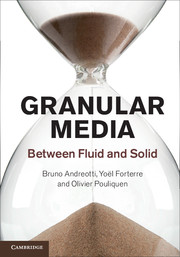7 - Immersed granular media
Published online by Cambridge University Press: 05 June 2013
Summary
This chapter is devoted to the properties of granular media immersed in a liquid. Mixtures of grains and fluids are used in many industrial processes, for example in civil engineering projects with concrete. In environmental problems, the coupling between a granular soil and water controls the soil stability and is important in the understanding of many natural disasters such as landslides and mud flows. The physics of two-phase flows involving grains and liquid is a vast area of research. In this book dedicated to granular media, we will restrict ourselves to the high-concentration regime, for which the grains are in contact and interact primarily through contact interactions. Our goal is to illustrate through examples how the concepts developed in the previous chapters on dry granular materials are modified in the presence of an interstitial fluid. In the first part (Section 7.1) we introduce two-phase-flow equations, the relevant theoretical framework for studying immersed granular media. In this approach, the granular medium and the liquid are described as two interpenetrating continuum media, which interact. In the second part, the use of two-phase-flow equations is illustrated in simple examples for which the granular skeleton is static (Section 7.2) and for which it is slightly deformed (Section 7.3). Finally, the influence of the interstitial fluid on the rheology of sheared granular media is discussed in Section 7.4.
- Type
- Chapter
- Information
- Granular MediaBetween Fluid and Solid, pp. 285 - 310Publisher: Cambridge University PressPrint publication year: 2013



